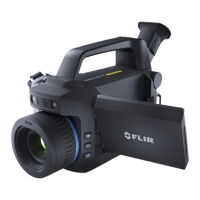Quantification
9
provide sufficient contrast to quantify the plume. This is critical for an accurate
measurement.
• Select a location suitable for the camera. You will need to mount the camera on a tri-
pod so look for a relatively flat surface within a reasonable distance of the leak.
It is best to place the camera at a distance somewhere between 5 to 15 feet for small
leaks and from 20 to 40 feet for large leaks. See also section 9.4.1.1 Distance and
range.
9.4.1.1 Distance and range
Distance from the camera to the gas leak is another parameter you will need to enter into
the quantification module. While the quantification feature is agnostic to range (i.e., the
quantification feature will operate at any distance within the method limits), you must pro-
vide this distance for accurate quantification.
The range for the quantification feature is a function of the lens attached to the camera.
For the 23 mm lens (24° FOV) the range is from 5 feet to 54 feet (1.5 to 16 meters). For
the 38 mm lens (14° FOV) the range is from 8 feet to 90 feet (2 to 27 meters) For the 92
mm lens (6° FOV) the range is from 20 feet to 210 feet (6 to 64 meters). In general, small
leaks should be measured near the bottom of the range and large leaks should be meas-
ured near the top of the range.
9.4.2 Measure Ambient Temperature
The ambient air temperature is one of the parameters you will need to provide to the
quantification module. The measurement of this air temperature should be taken within
the same general area as the gas leak, although it is not necessary to get into the midst
of the gas leak. A measurement taken at the location of the camera is generally accept-
able unless there is a significant temperature gradient between the leak location and the
location of the camera. A measurement read off an instrument like a smart phone that
gives the general temperature of the city is NOT recommended as local temperature can
vary considerably (especially in close proximity to process equipment).
A few words of caution when obtaining the air temperature:
• Do not place the thermometer in direct sunlight as the solar heating tends to bias the
reading high.
• Do not place the thermometer on the ground as this may not be representative of true
ambient air temperature.
• Ideally the thermometer should be placed in a position where it is exposed to the
same free-flow ambient air conditions as the gas plume and free from potential inter-
ferences such as direct sunlight or other radiating heat sources.
It is strongly recommended that the ambient temperature be measured each and every
time a quantification is performed.
9.4.3 Assessing delta temperature
Use the Delta T feature to show areas of the field of view where there is insufficient delta
temperature for quantification. Those areas will be highlighted red.
If parts of the scene are below the minimum delta temperature, it may still be possible to
perform a measurement. If you can position the camera so that the measurement ring is
placed in a region of good delta temperature, then you can proceed with the measure-
ment. If that is not possible, try changing the viewing angle. Recall that for quantitative
optical gas imaging, both reflected energy and emitted energy contribute to the apparent
temperature. It is often possible to change the apparent temperature just by changing
the viewing angle to the background, thereby changing the amount of energy reflected to
the camera. If you can find no angle or camera position that provides sufficient delta tem-
perature, then you may not be able to perform a measurement. Returning to the site at a
different time of day will often yield a different delta temperature.
#T810605; r. AD/92464/92464; en-US
45

